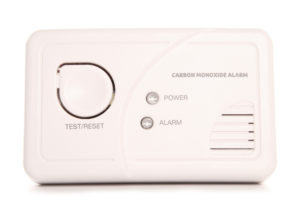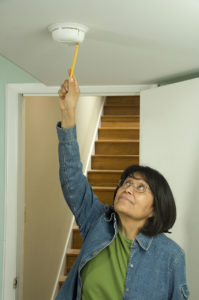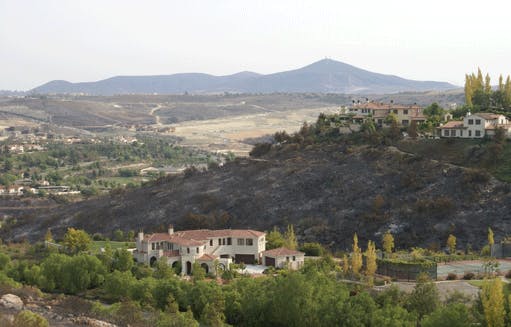Home Protection Systems
Having functioning home protection systems in place is important for keeping your family safe. Installing and maintaining carbon monoxide alarms, smoke alarms, and residential fire sprinklers provides your family with the best protection during an emergency situation.
According to the Environmental Protection Agency, carbon monoxide (CO) is an odorless, colorless, toxic gas. Because it is impossible to see, taste, or smell the toxic fumes, CO can harm you before you are aware it is in your home. At lower levels of exposure, CO causes mild effects that are often mistaken for the flu. These symptoms include headaches, dizziness, disorientation, nausea and fatigue. The effects of CO exposure can vary greatly from person to person depending on age, overall health and the concentration and length of exposure.

CO can be produced by any natural or fossil fuel source. This can include, but is not limited to: gas space heaters; leaking chimneys, furnaces, and wood stoves; gas water heaters; gas stoves; gasoline powered equipment and automobiles; and tobacco smoke.
There are ways to protect your family from CO poisoning. Make sure all gas appliances are in good working condition. You may want to have someone from the gas company come out and inspect your gas lines for leaks. Keep your chimneys clear of debris and make sure your furnace is in good working order. Keep the door between the home and an attached garage closed.
The easiest thing to do to protect your family is to install a CO alarm, which can be purchased at many local hardware stores. Similar to smoke alarms, CO alarms detect the presence of CO in the air and make a noise to alert residents when the gas level approaches harmful levels. The state of California requires all "single-family homes with an attached garage or fossil fuel source to install carbon monoxide alarms."
If you suspect CO poisoning has occurred, call 9-1-1. Ventilate area, turn off potentially problematic appliances, and leave the house. Do not re-enter the building until you are cleared to do so by emergency personnel. Make sure the paramedics and later, the physicians, know you suspect CO poisoning.
Resources:
- California State Fire Marshal FAQ
- List of California State Fire Marshal Approved Carbon Monoxide Alarms and Detectors and Smoke Alarms
- Cal Fire Carbon Monoxide Page
- Environmental Protection Agency Indoor Air Quality
Smoke alarms (also called smoke detectors) are inexpensive, life-saving devices designed to be the first line of defense to help families safely escape a residential fire. According to the National Fire Protection Association (NFPA), half of all home fire deaths occur between the hours of 10 p.m. and 6 a.m., when occupants are asleep.
When properly maintained, smoke alarms sense smoke when a fire is still small, alerting occupants of eminent danger and allowing time to escape. Contrary to what some believe, the smell of smoke typically does not wake a person from sleep; in fact, smoke's poisonous gases will actually numb the senses, causing one to fall into an even deeper slumber.
The following are some key points to know about smoke alarms:
Smoke Alarm Maintenance
The maintenance of smoke alarm involves selecting the proper alarm, proper placement, monthly testing, annual battery changes, and routine cleaning. Two types of battery-powered alarms are on the market today, ionization and photoelectric. These devices differ in the types of sensors used to detect smoke, yet both offer adequate protection if they are properly installed and maintained. Always purchase a device meeting the approval and bearing the label of the Underwriter's Laboratory (UL). The RSF Fire District recommends the installation of a hard-wired (or direct line), 110-voltage smoke detector system with battery back up.

Smoke Alarm Placement and Installation
Proper placement is crucial to the effectiveness of your smoke alarm. The Rancho Santa Fe Fire Protection District's Ordinance No. 2017-01 and current building codes require smoke alarms to be installed and maintained inside every bedroom, within every hallway, and at the top of all staircases in new homes and homes undergoing remodeling. The same placement is recommended for homes that have not undergone any remodeling. On floors without bedrooms, place the alarm in family rooms and living rooms. Avoid installing smoke alarms near the kitchen or bathrooms, as cooking vapors and steam often cause false alarms. If your home has a hard-wired smoke alarm system without battery back up, the RSF Fire District recommends upgrading the system to meet current code requirements. Hard-wired systems without battery-back up will not function if a fire occurs during a power outage.
Smoke rises; therefore, it's best to install alarms at the highest point on the ceiling, at least four inches away from the nearest wall. Install alarms away from windows, doors, or fireplaces as these areas may inhibit smoke from activating the unit.

Testing Your Smoke Alarms
Testing is another essential component in the maintenance of smoke alarms. Whether your home contains battery-powered or hard-wired alarms, make it a point to test each device once per month. As with any technical device, smoke alarms may malfunction at some point without warning. Regular testing is the only way to ensure detectors are working to their fullest life-saving potential.
To test your alarms, press and hold the button on the outside of the unit until the alarm sounds. If the unit is out of reach, stand under it and use a broom handle to press the button. Whenever possible, have family members help out during monthly smoke alarm testing. Teaching children and grandchildren fire-safe practices early in life will help them carry fire-safe actions into adulthood.
In addition to monthly testing, it is important to remember to exchange the old batteries in your smoke alarms with new ones once each year. Pick a date that will be easy to remember, like when you change your clocks each spring or fall, New Year's Day, or September 11. Batteries are considered to be "universal waste" and should be recycled properly, never in a trash can or blue recycle bin. 9v batteries, the type used most frequently in smoke alarms, should have electrical tape placed over the positive/negative end prior to disposal to prevent accidental fires. For more information on universal waste, including disposal locations, please visit EDCO or San Diego County's Universal Waste's webpages.
False Alarms
False alarms can be a nuisance, and are the main reason people remove the batteries from their alarms. Proper placement and cleaning should help curb false alarms. Since smoke alarms are prone to the collection of dust and cobwebs, follow the manufacturer's suggestions for cleaning. Typically a light dusting with a vacuum cleaner attachment works best. If false alarms persist, evaluate whether the unit is too close to the kitchen or bathroom, reinstall it in another area and the problems should subside. Try to determine whether your smoke alarms are 10 years or older. Older units are subject to random failures, and should be replaced. If the unit is making a "chirping" noise, it may simply need a battery replacement. Should problems continue, the alarm may be faulty and should be replaced immediately.
List of California State Fire Marshal Approved Carbon Monoxide Alarms and Detectors and Smoke Alarms
Residential fire sprinklers are designed to save lives by controlling or even extinguishing a fire. A threatening fire can generate enough heat (about 155°F) to trigger your sprinkler system and only the sprinkler closest to the fire will activate, spraying water directly on the fire and the area that the sprinkler has been designed to protect. When exposed to a high enough heat level, the sprinkler cap will fall off and the capsule in the sprinkler head will break, allowing water to flow. Sprinklers can control or even extinguish the fire before heat and smoke turn deadly, allowing you and your family to escape safely and limiting damage to your home. For an added layer of protection, your sprinkler system can be linked to the local fire company or home alarm system so that they are immediately notified when a sprinkler activates. However, most sprinklers are NOT monitored. If you ever hear sprinkler bell ringing, call 9-1-1.
To ensure the system is ready to go in case of a fire, it is important to be familiar with your system and maintain it. Spare sprinkler heads are found in the red box, which is usually located in the garage near the water supply or sprinkler riser. The box also contains the contractor’s name and phone number and a wrench. When replacing a sprinkler head, be sure you are using the exact same type of sprinkler head.
The flow switch causes the bell to ring if water is flowing. It also notifies the monitoring company for monitored homes. The gauge indicates proper water pressure. Exact pressure may vary from home to home but below 200 is considered normal. The water meter, located in front of your home near the street, can be used to turn off water flow in case of an activation. You will need a wrench to do this and it will shut off water to the entire home. The water can be turned on again once the activated head is replaced.
The fire sprinkler bell sounds when water flows through the fire sprinkler pipes to alert the homeowner and neighbors of an activation. It may take up to 40 secs for the alarm to start sounding. This is normal. If you hear a fire sprinkler bell ringing, CALL 9-1-1!
For your safety, and to be sure your automatic fire sprinkler is operating properly, remember the following “Dos and Don’ts:"
- DO VISUALLY check your system, including the sprinkler heads, for damage.
- DO NOT HANG anything from the fire sprinkler heads or pipes.
- DO NOT PAINT the fire sprinkler covers or heads.
- DO NOT TAMPER with the fire sprinkler heads.
- DO NOT HIDE sprinkler heads with furniture, decorations, etc.
- DO make sure the bell remains clear of debris, including bird nests, and that the label sign is visible at all times.
- DO test your system at least once a year.
PLEASE NOTE: Any work done to the fire sprinkler system is required to be conducted by a licensed C-16 contractor. A list of such contractors who have done work within the fire district can be downloaded below.
Inclusion on this list is not an endorsement nor is it necessary to do work within the fire district.
- Cover the area near where the water will flow prior to opening the Inspector's Test Valve to protect landscaping.
- Alert your monitoring company that you will be testing your system.
- Open the Inspector’s Test Valve to be sure water flows and the alarm sounds. There may be a short delay from the time the water flows to the time the bell sounds, about 35-40 seconds.
- Keep the area around the main water valve (located in front of your home near the street) clear so it remains easily accessible in case there is an emergency and you need to cut off the water supply to your home. You may wish to keep a crescent wrench with the meter.
- If you encounter an issue with your home fire sprinkler system, contact a fire sprinkler contractor. A plumber is not certified to work with home sprinkler systems unless he/she has a C16 Contractor license.
IMPORTANT! Tampering with your fire sprinkler system in any way may compromise it and cause it to not function properly in the case of a fire. This could lead to greater property damage and possibly even death.

